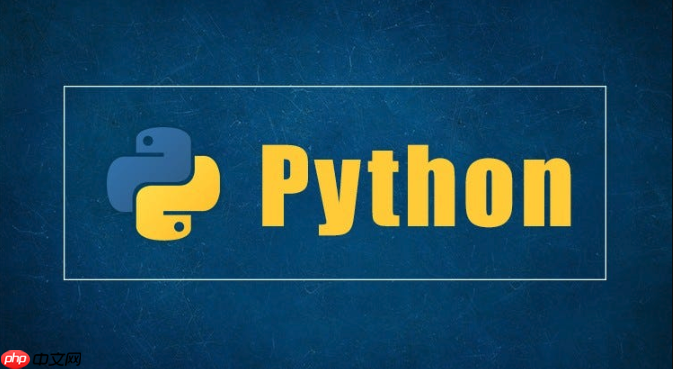类方法通过cls参数访问类属性并感知子类,适用于替代构造器和修改类状态;静态方法不绑定类或实例,仅作逻辑分组的工具函数。

在Python中,静态方法(
@staticmethod
@classmethod
解决方案
当我们谈论Python类中的方法时,通常会想到实例方法,它们通过
self
@classmethod
@staticmethod
类方法(@classmethod
立即学习“Python免费学习笔记(深入)”;
类方法,顾名思义,是绑定到类而不是类的实例的方法。它的第一个参数约定俗成地是
cls
class Car:
wheels = 4
def __init__(self, brand, model):
self.brand = brand
self.model = model
def display_info(self):
print(f"{self.brand} {self.model} with {Car.wheels} wheels.")
@classmethod
def change_wheels(cls, new_wheels):
"""类方法:修改类的属性"""
cls.wheels = new_wheels
print(f"所有汽车现在都有 {cls.wheels} 个轮子了。")
@classmethod
def from_string(cls, car_string):
"""类方法:替代构造器,从字符串创建Car实例"""
brand, model = car_string.split('-')
return cls(brand, model)
# 正常创建实例
my_car = Car("Toyota", "Camry")
my_car.display_info()
# 使用类方法修改类属性
Car.change_wheels(6) # 所有的Car实例都会受到影响
your_car = Car("Honda", "Civic")
your_car.display_info() # 发现轮子数变了
# 使用类方法作为替代构造器
another_car = Car.from_string("BMW-X5")
another_car.display_info()这里,
change_wheels
cls
Car.wheels
Car
wheels
from_string
__init__
cls(brand, model)
Car
Car
静态方法(@staticmethod
静态方法则更像是定义在类内部的普通函数。它不接受任何隐式的第一个参数(无论是
self
cls
import datetime
class MyDate:
def __init__(self, year, month, day):
self.year = year
self.month = month
self.day = day
def display_date(self):
print(f"{self.year}-{self.month}-{self.day}")
@staticmethod
def is_valid_date(year, month, day):
"""静态方法:检查日期是否有效,不依赖MyDate实例或类状态"""
try:
datetime.date(year, month, day)
return True
except ValueError:
return False
@staticmethod
def get_max_days_in_month(year, month):
"""静态方法:获取某月最大天数,不依赖MyDate实例或类状态"""
if month == 2:
return 29 if (year % 4 == 0 and year % 100 != 0) or (year % 400 == 0) else 28
elif month in [4, 6, 9, 11]:
return 30
else:
return 31
# 使用静态方法
print(MyDate.is_valid_date(2023, 2, 29)) # False
print(MyDate.is_valid_date(2024, 2, 29)) # True
print(MyDate.get_max_days_in_month(2023, 2)) # 28
print(MyDate.get_max_days_in_month(2024, 2)) # 29
# 创建实例
d = MyDate(2023, 10, 26)
d.display_date()is_valid_date
get_max_days_in_month
MyDate
MyDate
self.year
MyDate
MyDate.format_string
什么时候应该优先选择类方法,而不是静态方法?
这个问题我经常思考。在我看来,选择类方法而非静态方法,核心在于你的方法是否需要与“类”本身进行交互。如果你需要访问或修改类的属性(而不是实例的属性),或者你希望这个方法在继承链中能够感知到具体的子类类型,那么类方法就是不二之选。
最典型的场景就是替代构造器(Alternative Constructors)。想象一个
User
User.from_dict(data)
from_dict
User(name, email)
User
AdminUser
AdminUser
from_dict
AdminUser.from_dict
AdminUser
User
cls
class User:
def __init__(self, name, email):
self.name = name
self.email = email
@classmethod
def from_dict(cls, data):
return cls(data['name'], data['email'])
def greet(self):
print(f"Hello, I'm {self.name}.")
class AdminUser(User):
def __init__(self, name, email, admin_level):
super().__init__(name, email)
self.admin_level = admin_level
def greet(self):
print(f"Hello, I'm Admin {self.name} (Level {self.admin_level}).")
# 使用类方法作为替代构造器
user_data = {'name': 'Alice', 'email': 'alice@example.com'}
admin_data = {'name': 'Bob', 'email': 'bob@example.com', 'admin_level': 5}
u = User.from_dict(user_data)
u.greet() # Hello, I'm Alice.
# 如果AdminUser也需要from_dict,并且它没有自己的from_dict实现,
# 继承的User.from_dict会因为cls参数而正确地创建AdminUser实例。
# 注意:这里为了演示,from_dict需要知道admin_level,
# 所以AdminUser通常会重写from_dict或者User.from_dict需要更灵活的设计。
# 但核心思想是:cls会指向AdminUser。
# 假设from_dict能够处理admin_level
# 实际上,如果AdminUser有额外的参数,User的from_dict可能不适用,
# AdminUser会重写from_dict来处理自己的特有参数。
# 但如果User的from_dict只处理通用参数,并且子类不需要额外参数,
# 那么继承的from_dict就会工作。
# 为了更清晰地演示cls的指向,我们简化一下:
class Base:
@classmethod
def create(cls):
print(f"Creating instance of {cls.__name__}")
return cls()
class Derived(Base):
pass
b = Base.create() # Creating instance of Base
d = Derived.create() # Creating instance of Derived看,
Derived.create()
cls
Derived
静态方法在Python类的设计中扮演什么角色?
静态方法在Python类的设计中,主要扮演着“辅助工具”或“逻辑分组”的角色。它们提供了一种将与类逻辑相关但又不需要访问类或实例状态的函数,组织到类命名空间下的方式。我经常把它们看作是模块级别的函数,只不过它们被“装箱”到了一个类里面,以表明它们与这个类有某种概念上的关联。
它们最常见的用途包括:
MathUtils
add
subtract
Validator
is_email_valid
DateTimeParser
format_date_string
class TextProcessor:
def __init__(self, text):
self.text = text
def process(self):
# 实例方法处理文本
processed_text = TextProcessor.clean_text(self.text)
processed_text = TextProcessor.normalize_case(processed_text)
return processed_text
@staticmethod
def clean_text(input_text):
"""静态方法:移除特殊字符,不依赖实例或类状态"""
# 假设这里有一些复杂的清洗逻辑
return ''.join(char for char in input_text if char.isalnum() or char.isspace())
@staticmethod
def normalize_case(input_text, case='lower'):
"""静态方法:统一大小写,不依赖实例或类状态"""
if case == 'lower':
return input_text.lower()
elif case == 'upper':
return input_text.upper()
return input_text
# 使用静态方法
raw_text = "Hello, World! This is a Test."
cleaned = TextProcessor.clean_text(raw_text)
normalized = TextProcessor.normalize_case(cleaned, 'upper')
print(f"Cleaned: {cleaned}")
print(f"Normalized: {normalized}")
# 实例使用静态方法
processor = TextProcessor(raw_text)
final_text = processor.process()
print(f"Processed by instance: {final_text}")在这个例子中,
clean_text
normalize_case
TextProcessor
self.text
TextProcessor.config
类方法和静态方法在继承中的行为有何不同?
在继承中,类方法和静态方法的行为差异是它们之间一个非常重要的区分点。这直接关系到多态性和代码的灵活性。
类方法在继承中的行为:
正如前面提到的,类方法通过
cls
cls
class Animal:
species_count = 0
def __init__(self, name):
self.name = name
Animal.species_count += 1 # 每次有实例创建就增加计数
@classmethod
def get_total_species(cls):
"""类方法:获取所有动物的种类计数"""
return cls.species_count
@classmethod
def create_animal_from_data(cls, data):
"""类方法:从数据创建实例,cls会指向调用者"""
print(f"Creating a {cls.__name__} instance.")
return cls(data['name'])
class Dog(Animal):
def __init__(self, name, breed):
super().__init__(name)
self.breed = breed
@classmethod
def create_dog_from_data(cls, data):
"""子类特有的类方法,也可以调用父类的通用逻辑"""
print(f"Creating a specific Dog instance.")
return cls(data['name'], data['breed'])
# 演示类方法在继承中的行为
a1 = Animal("Generic Animal")
d1 = Dog("Buddy", "Golden Retriever")
print(f"Total species via Animal: {Animal.get_total_species()}") # 2
print(f"Total species via Dog: {Dog.get_total_species()}") # 2 (这里是继承的父类方法,cls仍是Animal)
# 注意:如果子类没有重写get_total_species,它会调用父类的版本,
# 并且cls会是Dog,但get_total_species里用的是Animal.species_count,
# 这可能会导致一些误解。更严谨的做法是让species_count也成为一个类属性,
# 并且每个子类有自己的计数,或者get_total_species操作的是一个全局注册表。
# 这里主要展示cls的指向。
# 演示create_animal_from_data
animal_instance = Animal.create_animal_from_data({'name': 'Leo'}) # Creating a Animal instance.
dog_instance = Dog.create_animal_from_data({'name': 'Max'}) # Creating a Dog instance.
print(f"Type of dog_instance created by inherited classmethod: {type(dog_instance)}") # <class '__main__.Dog'>
# 演示子类特有的类方法
specific_dog = Dog.create_dog_from_data({'name': 'Lucy', 'breed': 'Labrador'})
print(f"Type of specific_dog: {type(specific_dog)}") # <class '__main__.Dog'>可以看到,当
Dog.create_animal_from_data
cls
Dog
return cls(data['name'])
Dog
Animal
静态方法在继承中的行为:
静态方法在继承中的行为则非常简单,它就像一个普通的函数被复制到了子类的命名空间中。它不关心自己是被哪个类调用,因为它不接收
self
cls
class Calculator:
@staticmethod
def add(a, b):
return a + b
@staticmethod
def subtract(a, b):
return a - b
class AdvancedCalculator(Calculator):
@staticmethod
def multiply(a, b):
return a * b
# 演示静态方法在继承中的行为
print(Calculator.add(5, 3)) # 8
print(AdvancedCalculator.add(10, 2)) # 12 (子类调用父类的静态方法,行为不变)
print(AdvancedCalculator.multiply(4, 5)) # 20
# print(Calculator.multiply(2, 3)) # AttributeError: type object 'Calculator' has no attribute 'multiply'AdvancedCalculator
Calculator
add
subtract
AdvancedCalculator.add
Calculator.add
总结来说,如果你需要一个方法能够感知到调用它的具体类(尤其是在继承链中),并能操作类属性或创建该类的实例,那么选择类方法。如果你的方法只是一个与类逻辑上相关,但不需要访问类或实例任何状态的纯函数,那么静态方法是更简洁、更明确的选择。

python怎么学习?python怎么入门?python在哪学?python怎么学才快?不用担心,这里为大家提供了python速学教程(入门到精通),有需要的小伙伴保存下载就能学习啦!

Copyright 2014-2025 https://www.php.cn/ All Rights Reserved | php.cn | 湘ICP备2023035733号